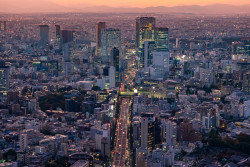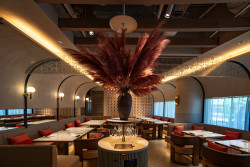
November 11, 2010
Sky High
Traveling overseas has become a lot easier with the opening of a new runway and international terminal at Haneda
By Metropolis
Originally published on metropolis.co.jp on November 2010
The biggest gripe that international travelers have about Tokyo is that its airport is too far from the city center. No more. On October 21, Haneda airport, officially known as Tokyo International Airport, opened a fourth runway and a gleaming new international terminal building. Government officials hope this will be the first step toward Japan having a 24-hour hub to compete with other Asian cities. Amid the recession, the stakes are enormous for airlines, travel agencies, regional industries—and especially Narita Airport in Chiba.With the opening of the 2,500-meter runway, regular international flights have resumed at Haneda for the first time since 2002. By next spring, the airport will be linked with 17 cities in Asia, Europe and North America, including Seoul, Beijing, Hong Kong, Singapore, Kuala Lumpur, Paris, London, Honolulu, LA, New York, Detroit and Vancouver. Airlines inaugurating new international services include JAL, ANA, Malaysia’s AirAsia X, Thai Airways, Cathay Pacific Airways, Hawaiian Airlines, American and Delta.
Japan Airport Terminal Co. (JATC), which operates Haneda, expects 7 million passengers per year to use the new facility, whose construction began way back in May 2008. Some 90,000 slots—60,000 day and 30,000 night—have been allocated annually to international flights. Utilizing the ten aircraft parking bays, daytime operations (classified as those between 6am and 11pm) center on flights between Haneda and destinations in China, South Korea and the rest of East Asia, while nighttime operations (10pm-7am) accommodate flights to Europe, the US and some other Asian cities.
During an “open house” prior to the terminal’s opening, JATC officials were out in force, showcasing the new facility, which is located only 15 kilometers from the heart of Tokyo. The five-story building has 74 shops and restaurants in areas accessible to all visitors, and 31 stores in the security area for passengers who have completed embarkation procedures. It also features a planetarium and period shops that recreate the feel of an Edo-era shotengai.
Narita veterans will appreciate how easy it is to get to and from Haneda. The Keikyu line offers service to a new station located adjacent to the international terminal, as does Tokyo Monorail, which transports passengers from Hamamatsucho station in just 15 minutes. Airport limousine buses have extended their routes to the new facility, and now offer late-night and early-morning runs as well. Bus services have started on new routes too, linking Haneda with hotels in Roppongi, Ebisu, Shirokane, Shiba, Shiodome and Shinjuku. Travelers opting for taxis can utilize three Keikyu Group companies offering fixed rates to five areas in Tokyo. Fares range from ¥6,000 to ¥11,000, depending on the area and time of day.
A pair of tourist information centers located in the second-floor arrival lobby help arriving visitors, with staff proficient in Japanese, English, Chinese and Korean. One of the centers is operated by the Tokyo Metropolitan Government, providing general information on sightseeing and transport, while the other, run by Keikyu, also offers tips on hotels and can help with restaurant reservations. In a special promotion that runs until March 31, foreign travelers who show their passports at the Keikyu center have the option of purchasing a prepaid Pasmo card and novelty Pasmo case. JR also runs an info center at the monorail station, where travelers can buy Japan Rail Passes, JR East passes and JR tickets.
To help christen the new facilities, travel agencies have launched a variety of Haneda-focused campaigns. JTB is selling package tours to 22 overseas cities, including the US West Coast. A spokesperson says the biggest demand is for tours that leave late at night on a Friday and return to Haneda by early Monday morning, thus allowing quick weekend getaways to places such as Taiwan, South Korea and China.
Japanese airlines ANA and JAL, and low-cost carriers such as Malaysia’s AirAsia X, are certainly in the best position to take advantage of the new terminal. JAL is operating seven daily flights to six international destinations—Paris, San Francisco, Honolulu, Bangkok, Taipei and Singapore—in addition to its current daily flights from Haneda to Seoul, Shanghai, Beijing and Hong Kong. JAL President and CEO Masaru Onishi told a news conference: “With JAL’s extensive domestic operations at the hub, passengers can make smooth connections from our new international flights to many other destinations in Japan.” Rival ANA is flying from Haneda to Los Angeles, Honolulu, Singapore, Bangkok and Taipei. ANA officials said they are counting on the airline’s fast connections to its domestic network.
New entrants in the market have high hopes for Haneda as well. Malaysian low-cost carrier AirAsia X announced—with great fanfare—a service connecting Kuala Lumpur and Haneda from December 9. Tickets cost just ¥10,000-¥22,000 for economy class. “This day has been a long time coming; we have been planning our entry of service into the Japanese market for well over two years,” CEO Azran Osman-Rani told a press conference. “We want to make travel more affordable for the broader population in Malaysia, who can visit the huge, diverse culture of Japan, and we equally wish to extend [an invitation] to the Japanese to come visit us.”
Another newcomer is Hawaiian Airlines, which begins service to and from Honolulu this week. The outbound flight departs Haneda at 11:59pm and arrives at Honolulu International Airport just after noon—on the same calendar day. Initially, Hawaiian will use a Boeing 767-300ER aircraft seating up to 264 passengers before introducing its larger 294-seat Airbus A330-200. The airline is counting on Japanese customers taking the late-night flight after a full day’s work.
The 10pm-7am time slots are causing some big challenges for European and mainland US carriers, however. For example, American (to and from LA) and Delta (Detroit, LA) must pay exorbitant parking fees to keep their planes on the tarmac at Haneda all day after their early-morning arrival; ideally, they’d like to get in the air again as quickly as possible. The airlines can’t schedule flights from Haneda before 7am because passengers don’t like early-morning flights, nor would those times be convenient for connecting flights from other Japanese cities (not to mention that trains to Haneda don’t run early enough). British Airways’ five-times-a-week service to Haneda, which begins in February 2011, will depart from London Heathrow at 8am and arrive at 5am. Its planes, too, must stay on the ground all day before a late-night departure.
Another big question is how the new international terminal will affect Narita airport. Last year, then transport minister Seiji Maehara caused a stir by saying he hopes to see Haneda become a 24-hour Asian hub. But in terms of international capacity, the airport—with its 90,000 international slots a year—can’t compete with Narita, which currently offers 220,000 slots and plans to expand that figure to 300,000 by 2014. Haneda officials, for their part, said their late-night flights to Asia will draw some passengers away from Narita. For example, if you’re flying to South Korea, why take two hours to get out to Narita for a two-hour flight when you can get to Haneda in much less time?
Chris Betros is the editor of Japan Today (www.japantoday.com).








